Food and beverage (F&B) services are the cornerstone of the hospitality industry, shaping unforgettable dining experiences. From the elegance of table service to the autonomy of self-service, each type of service caters to different guest preferences and occasions.
This blog explores the 4 main types of food and beverage services and their subcategories, such as English service, American service, French service, Room service etc, highlighting their features, advantages, and drawbacks.
By the end of this post, you’ll gain valuable insights into F&B service types, helping you choose or implement the perfect service style for any setting.
Here are the 4 main types of F&B service:
This infographic provides a clear breakdown of the four main types, helping professionals and students alike.

Let’s dive into the details of each type and its variations to better understand how they contribute to the guest experience.
Watch this quick video for a visual guide to the different types of food and beverage service in the hospitality industry:”
1. Table Service
Table service is a formal style where guests are seated, and the wait/staff takes care of orders and serving. It is known for its personalized attention, making it ideal for high-end and fine dining establishments.
This service type focuses on presentation, ambience, and professional execution. Its variations cater to different levels of luxury and interaction.
1.1 English or Family Service
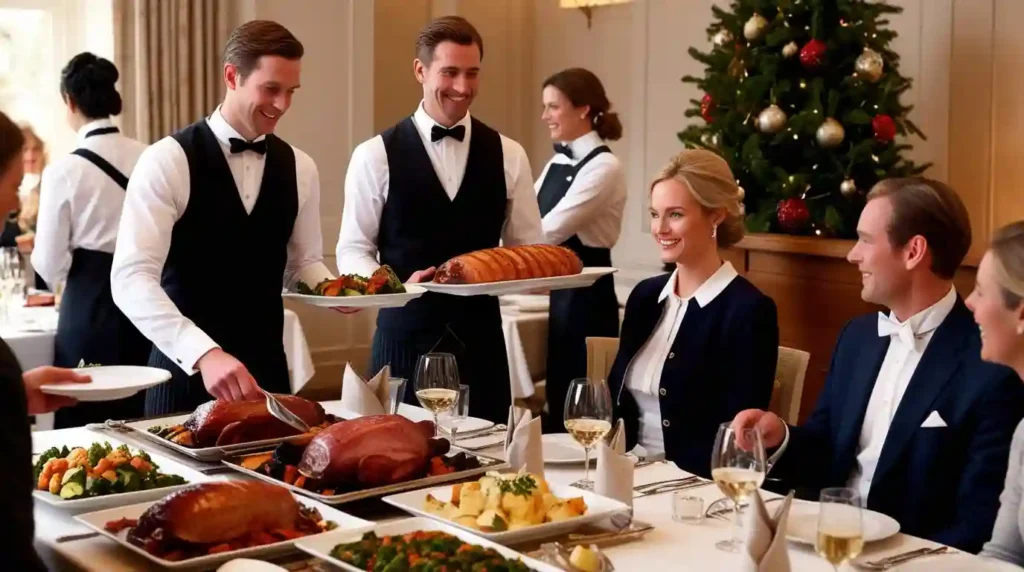
English service emphasizes a communal dining experience. Food is presented on large platters, shown to the host, and placed on the table. Guests either serve themselves or are served by the host or waiter.
This style encourages a relaxed, family-like atmosphere and is popular in speciality or celebratory dining. Suitable for occasions that require longer dining durations, this service fosters interaction among diners.
The food is brought to the table on large platters. The host may serve the guests or allow the waiter to serve.
Advantages:
- Encourages social interaction and creates a homely dining atmosphere.
- Ideal for events or occasions that require leisurely dining.
Disadvantages:
- Service can be slower, especially for larger groups.
- Requires skilled staff to manage large portions and maintain presentation.
1.2 American or Plate Service

American service is an efficient method where food is plated in the kitchen and served directly to guests. Known for its speed and consistency, this style is popular in casual dining and fast-paced environments.
Its simplicity minimizes the need for extensive staff training, making it a practical choice for chain restaurants and diners.
The kitchen predetermines portions, plates the food, and serves it directly to the guests.
Advantages:
- Ensures consistency in portion size, presentation, and quality.
- Reduces service time, making it ideal for high-turnover establishments.
Disadvantages:
- Limited interaction between guests and staff reduces personalization.
- Offers little opportunity for customisation once the food is plated.
1.3 French Service
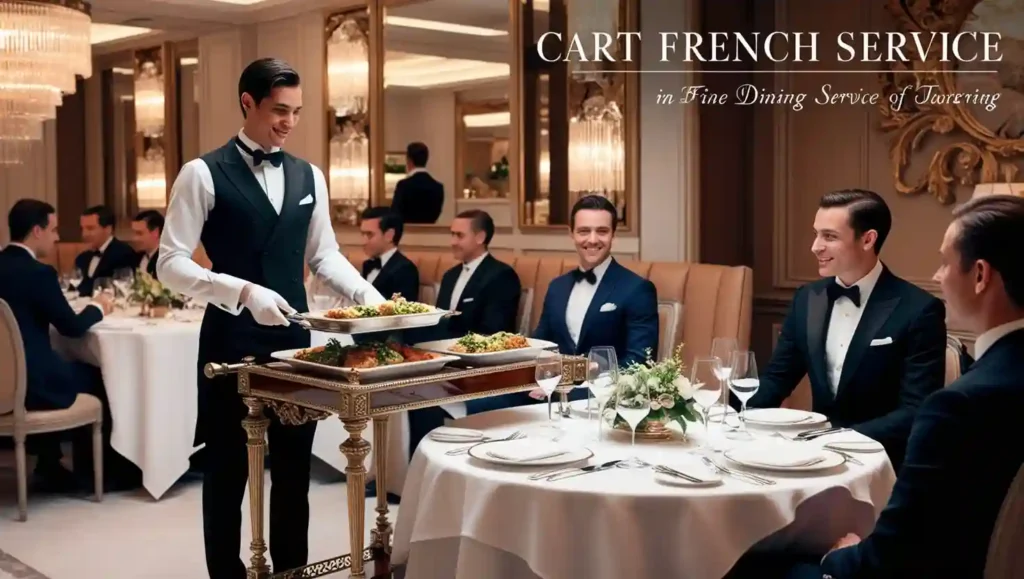
A luxurious and intricate service style, French service offers food in platters and casseroles, placed near the guests. They can either serve themselves or be served by staff.
Cart French Service involves tableside preparation, while Banquet French Service is suitable for large gatherings with pre-plated servings. Its exclusivity makes it common in VIP or fine dining settings.
Personalized service involving platters and casseroles placed near the guests for self-service.
Advantages:
- Enhances the guest experience with its elegant and theatrical presentation.
- Offers high levels of customisation for diners.
Disadvantages:
- Time-consuming and requires highly skilled staff.
- Higher operational costs due to specialized equipment and training.
1.4 Gueridon Service
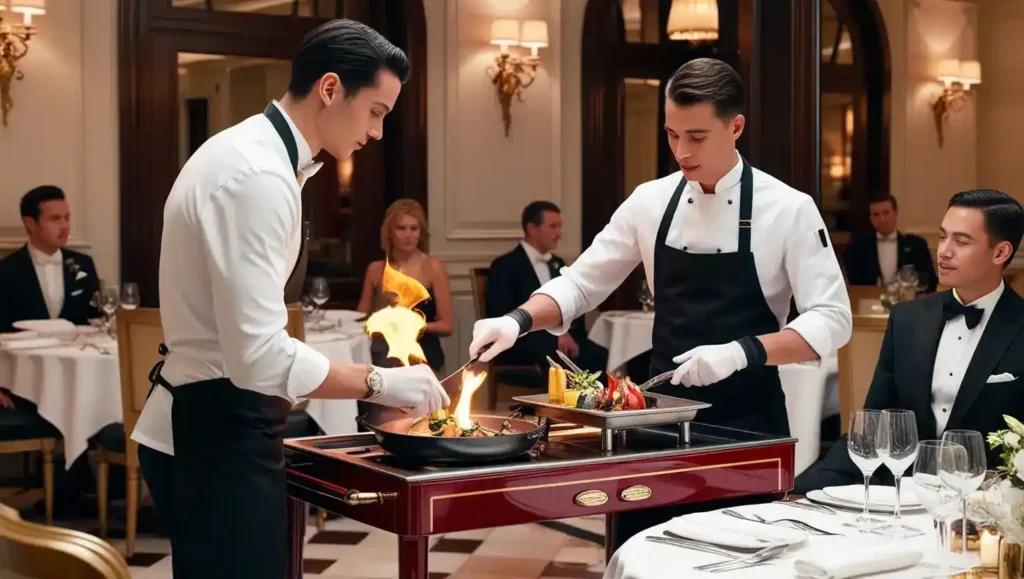
This style combines cooking and serving, with partially prepared dishes finished tableside using a Gueridon trolley. It adds drama and engagement, enhancing the guest experience.
Skilled staff are essential for this service, as they handle both preparation and presentation. Common for flambé dishes or speciality meals, Gueridon’s service impresses with its showmanship.
Food is partially cooked in the kitchen and finished tableside on a Gueridon trolley.
Advantages:
- Provides a memorable and engaging dining experience.
- Highlights staff expertise and enhances the meal’s presentation.
Disadvantages:
- Requires skilled staff and specialized equipment like Gueridon trolleys.
- It can be challenging to execute in busy or high-volume settings.
1.5 Silver Service

In silver service, food is presented on elegant silver platters and served to guests using specialised serving spoons and forks. The method requires precision and training, focusing on refined elegance
Silver service is synonymous with sophistication and tradition, making it a preferred choice for formal dining events. Its meticulous serving technique ensures an elevated guest experience,
Food is presented on silver platters and served to guests using spoons and forks.
Advantages:
- Enhances the formality and elegance of dining experiences.
- Suitable for high-profile events and exclusive banquets.
Disadvantages:
- Demands highly skilled staff for precise serving techniques.
- Involves higher costs due to silverware and formal settings.
1.6 Russian Service

Similar to Cart French Service, food is plated in the kitchen and served from the left side. It balances efficiency with elegance, making it suitable for formal yet straightforward service environments.
Similar to Cart French Service, but the food is pre-plated and served from the left side.
Advantages:
- Combines formal service with practical execution.
- Ideal for settings that require both elegance and efficiency.
Disadvantages:
- Lacks the interactive elements of Gueridon or French service.
- Additional staff training is required for proper serving techniques.
2. Assisted Service
Assisted service combines the elements of self-service and table service, offering a balance between convenience and staff support. This style is popular in casual settings, events, and hotels, where large groups of guests can be served efficiently.
Guests typically serve themselves from counters or buffets while staff provide assistance, such as replenishing dishes or offering guidance.
2.1 Buffet Service
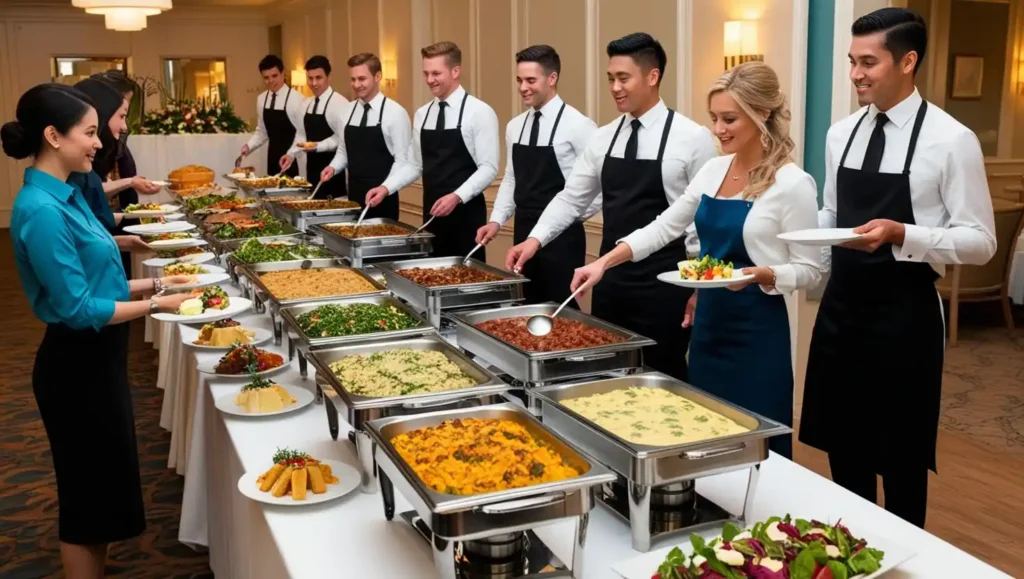
Buffet service involves a variety of dishes laid out on counters, allowing guests to serve themselves. Sit-down buffets often include pre-set tables to enhance comfort.
This service is commonly used in hotels, events, and celebrations due to its ability to accommodate large groups. Guests enjoy the flexibility to choose from a wide array of options at their own pace.
Guests serve themselves from a spread of food laid out on a buffet table.
Advantages:
- Cost-effective for serving large groups of people.
- Provides variety and flexibility in meal choices.
Disadvantages:
- Food wastage is common due to self-service.
- Requires constant replenishment and staff monitoring.
2.2 Cafeteria Service

In cafeteria service, guests queue at counters to select pre-prepared items before carrying their trays to a seating area. This fast-paced style is widely used in schools, offices, and hospitals, offering a functional and efficient dining experience.
It focuses on convenience and speed, catering to guests with limited time.
Guests pick food from a counter and carry their plates to the table.
Advantages:
- Ensures quick service and minimal waiting times.
- Reduces staffing requirements compared to full-service setups.
Disadvantages:
- Limited menu options may not satisfy all guests.
- Creates a less personalised dining experience
3. Self-Service
Self-service grants guests full autonomy over selecting, paying for, and consuming their food. It minimises staff involvement while maximising efficiency. Common examples include food courts, kiosks, and takeaway counters.
This style is ideal for fast-paced environments and casual dining, emphasising convenience and speed. It’s a popular option among the types of F&B services in hotels that prioritise high turnover and low costs.
3.1 Food Courts
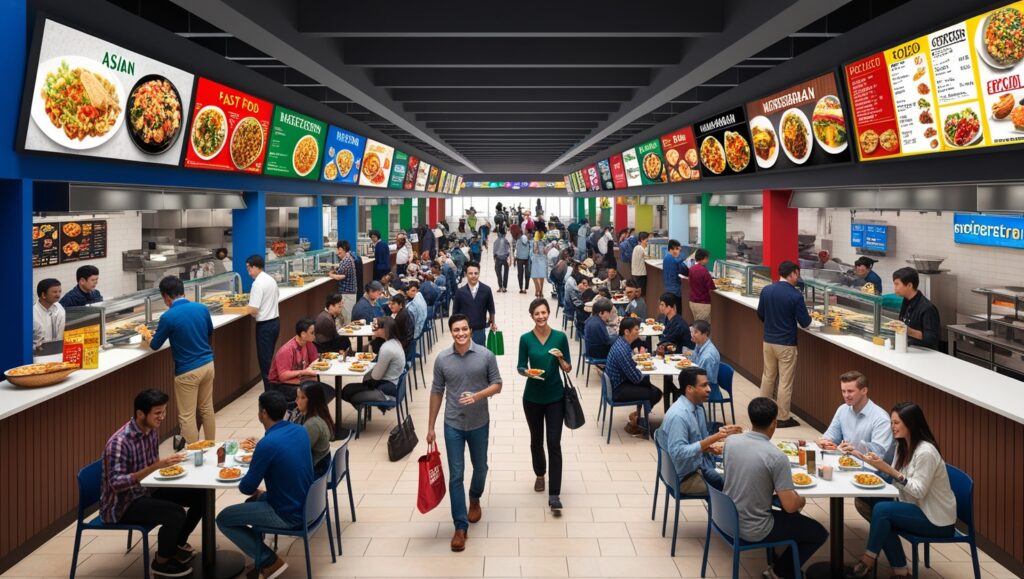
Food courts feature multiple vendors offering a variety of cuisines, with shared seating areas for diners. Guests can explore different food options in one location, making it a preferred choice in malls, airports, and commercial hubs. This style ensures diversity and accessibility.
A centralized area with multiple counters offering various cuisines.
Advantages:
- Wide variety of cuisines in one setting.
- Encourages flexibility and choice for diners.
Disadvantages:
- Crowded seating areas can reduce comfort.
- Lacks personalised service for guests.
3.2 Kiosks and Vending Machines

Automated kiosks and vending machines offer quick grab-and-go options, catering to guests who prioritise speed and convenience.
These setups are ideal for locations like offices, transit hubs, and public areas, focusing on functionality.
Automated counters or machines dispense food and beverages upon payment.
Advantages:
- Operates round the clock with minimal staff involvement.
- Provides a fast and efficient dining solution.
Disadvantages:
- Limited to pre-packaged or quick-serve items.
- Cannot cater to dietary preferences or customization.
3.3 Takeaway
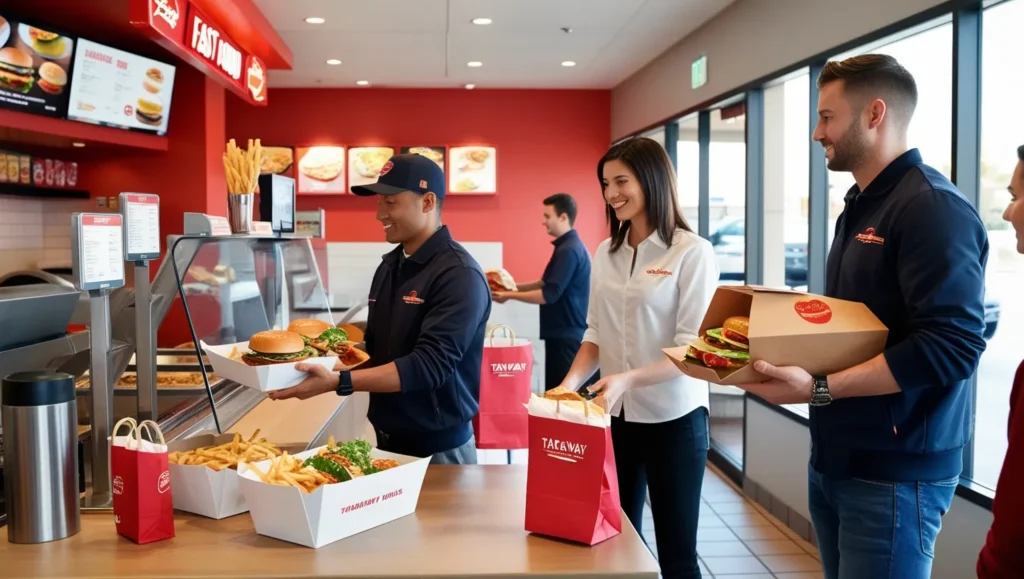
Takeaway service allows guests to order food for off-premises consumption. Paired with online ordering platforms, it caters to the modern demand for portability and convenience. This service style is prevalent in fast-food outlets and casual dining establishments.
Advantages:
- Offers convenience for guests with busy schedules.
- Reduces dining space requirements for establishments.
Disadvantages:
- Minimal interaction with guests may reduce brand connection.
- Challenges in maintaining food quality during transit.
4. Special Service
Special service adapts to non-traditional dining settings, focusing on meeting specific guest needs. It includes room service, trolley service, and other situational offerings tailored for unique experiences.
These styles enhance comfort and accessibility, making them a key part of the types of F&B service in hotels catering to diverse guest preferences.
4.1 Room Service

Room service delivers meals directly to guest rooms, offering privacy and convenience. Orders are placed via phone or apps, and meals are served on trays or trolleys. It’s a hallmark of luxury and comfort in hotels.
Food is delivered to guests in their hotel rooms.
Advantages:
- Ensures privacy and convenience for guests.
- Ideal for guests who prefer in-room dining.
Disadvantages:
- Requires additional staff and resources for timely service.
- Limited menu options compared to restaurant dining.
4.2 Tray Service
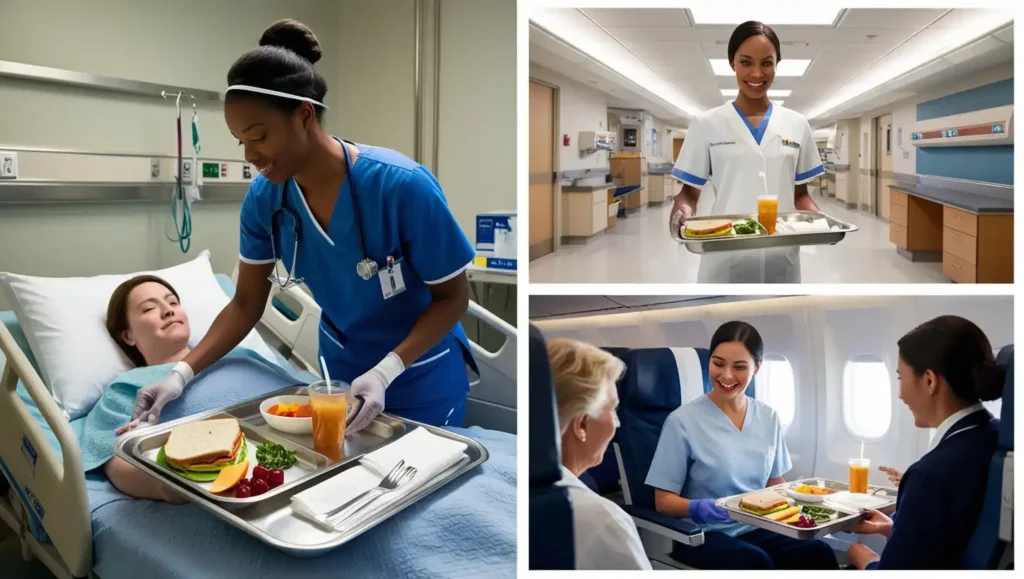
Tray service involves serving meals on compact trays, often used in hospitals, flights, or trains. This style prioritizes functionality and portability, catering to institutional or transit dining needs.
Meals are served on trays, often in institutional settings.
Advantages:
- Compact and portable, suitable for confined spaces.
- Streamlines service for large numbers of guests.
Disadvantages:
- Limited presentation quality of food.
- Relies heavily on pre-prepared items.
4.3 Home Delivery
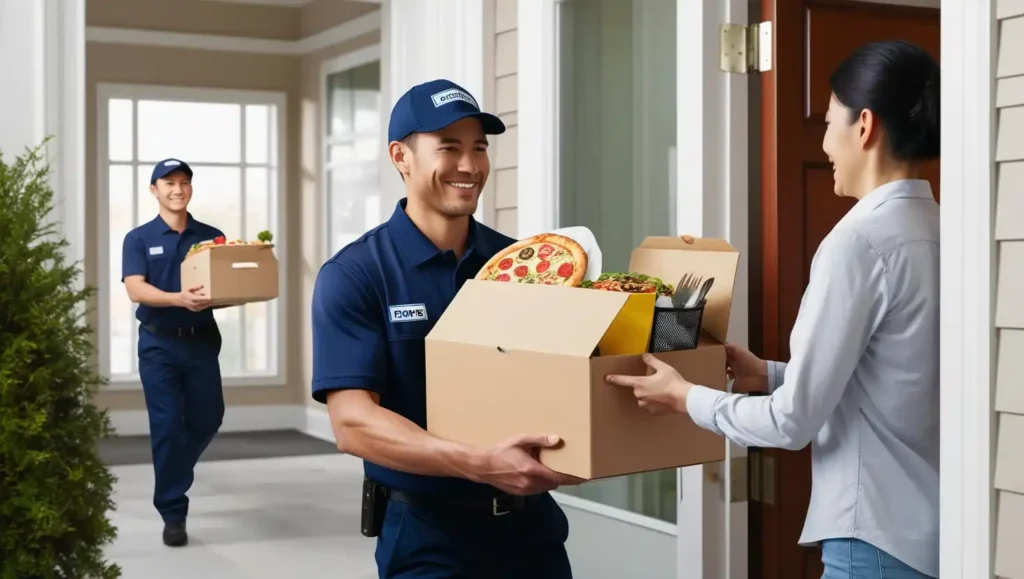
Home delivery brings meals to guests at their homes or workplaces. This service has gained popularity with online food delivery platforms, emphasizing speed and accuracy.
It’s a vital extension of the types of F&B service in hotels that cater to off-premises dining.
Food is delivered to customers’ homes or workplaces.
Advantages:
- Offers maximum convenience for guests.
- Expands reach beyond the physical premises of a restaurant.
Disadvantages:
- High dependency on reliable delivery networks.
- Potential for food quality degradation during transit.
4.5 Lounge Service

Lounge service provides food and beverages in comfortable, relaxed settings like airport lounges or hotel waiting areas. Menus are designed for variety and quick service, enhancing the guest experience in transit or downtime.
Food and drinks are served in a lounge area.
Advantages:
- Creates a luxurious and relaxed atmosphere.
- Ideal for guests seeking a casual yet upscale experience.
Disadvantages:
- It may not suit high-volume or budget-conscious operations.
- Requires frequent monitoring to maintain cleanliness and ambience.
4.6 Grill Room Service
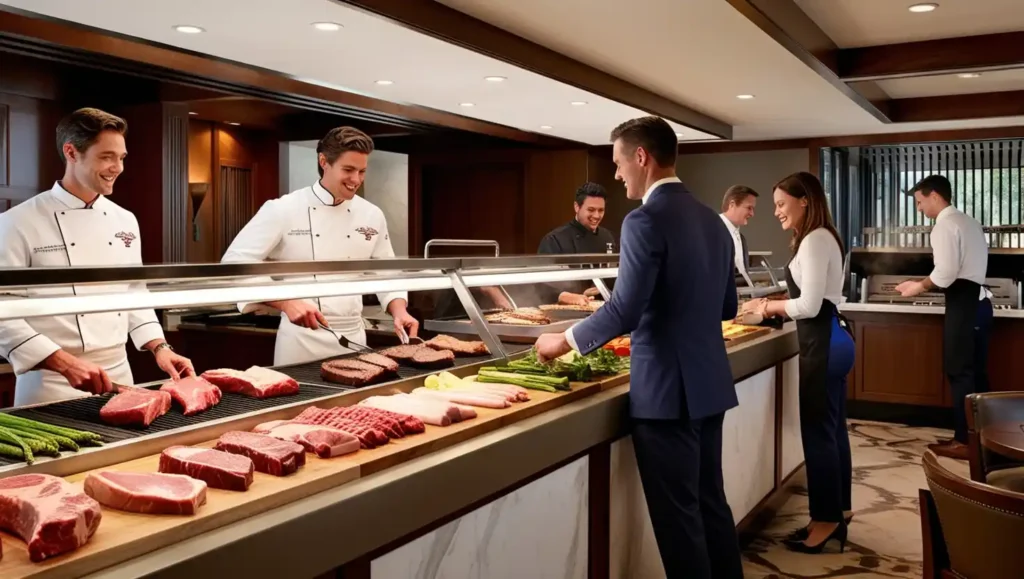
Grill room service allows guests to select raw ingredients, such as meats or vegetables, from a display. The selected items are then cooked to order, ensuring freshness and customization.
This style is popular in steakhouses, barbecue restaurants, and high-end hotel grill rooms, offering an interactive and engaging dining experience.
Guests select raw ingredients (meat, vegetables) that are cooked and served.
Advantages:
- Guarantees freshness and allows guests to customize their meals.
- Adds an element of interactivity and entertainment to the dining experience.
Disadvantages:
- Requires specialized kitchen equipment and skilled staff.
- Longer preparation times may lead to slower service for large groups.
Conclusion
The types of service in food and beverages are essential for creating a memorable dining experience. Whether it’s the formal and personalized approach of table service or the more casual and efficient methods like self-service, each type serves a unique purpose.
By understanding the different styles of service, restaurants can select the right style to meet customer needs, enhance satisfaction, and ensure smooth operations.
“Prefer reading offline? Download the complete guide on ‘Types of Food and Beverage Service’ as a PDF and access it anytime, anywhere. Save your copy now!“
FAQ Types of Food and Beverage service
What are the four main types of food and beverage service?
The four main types of food and beverage service are:
1. Table Service – where food is brought directly to the table.
2. Buffet Service – where customers serve themselves from a spread of food.
3. Self-Service – where customers choose and pick up food themselves, like in food courts.
4. Specialized Service – includes services like room service, bar service, and counter service.
Which type of food and beverage service is best for casual dining?
Self-service or buffet service are ideal for casual dining as they offer convenience and flexibility for customers in a relaxed environment.
What is specialized service in the F&B industry?
Specialized service includes unique offerings like room service, bar service, or counter service, tailored to specific guest needs and settings.


